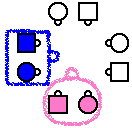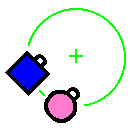

The difficulty of this method is the tendency that the sequence of the two couples can get flipped in your mind in the "heat of battle" during the resolve process. This is especially true if the key couples happen to be across the square from their homes when you're trying to evaluate the sequence.
I came up with an idea that really helps me see sequence much more easily.
"Girl Couple" / "Boy Couple"
Before calling...
Choose two adjacent couples (key couples). The couple on the "girl side" is the "Girl Couple". The couple on the "boy side" is the "Boy Couple".


Visualize each key couple as a single dancer: the "Girl Couple" is mentally replaced by a single imagined girl dancer standing where the couple is and facing the flagpole center of the set (no matter which way the actual dancers of the key couple are facing); likewise the "Boy Couple" is mentally replaced with a single imagined boy dancer. Visualize the two imagined single dancers as a couple facing the flagpole center of the set. If the "Boy Couple" is on the correct side of the "Girl Couple" for normal / standard arrangement for a couple, then the key couples in our sight square are "in sequence". If our imagined couple is sashayed, then the sight square must be out of sequence. Easy!
When memorizing the couples, you'll want to look for something (masculine / feminine) in each couple that will help make the "Girl Couple" and "Boy Couple" associations. I'll choose which couples to use as key couples based on the ease with which I can make the Girl-Boy association.
The critical skill required for this method is the ability to recognize at a glance which side of a standard arrangement couple the boy belongs and which side the girl belongs. You'll need to evaluate whether a couple as "normal / standard" or "sashayed" no matter which way the couple is facing, including odd angles.
When calling...
Call to get the partners in both key couples either paired or adjacent somehow around the perimeter of whatever formation you're in. Imagine the associated Boy / Girl dancers over each key couple; see them as a couple facing the flagpole center of the set (no matter which way the real dancers in the key couples are facing) then evaluate "normal / standard" or "sashayed"
You can also note which couple should be in front of the other as they Promenade: Think "Ladies before Gentlemen"
See Evaluating Order State With "Stripe" Pairing for more information on how to evaluate sequence in various formations using this method.
| An exercise to practice seeing "standard" or "sashayed" quickly
Get 3 different coins. Choose which will represent a Girl, a Boy, and a Centerpoint.
Spill the coins so they land randomly on a table or floor. With the centerpoint coin as a reference, imagine the other two coins as two adjacent dancers facing the centerpoint with hands joined circling around the centerpoint. (You'll occasionally need to fudge some odd arrangements of the coins into a clear picture in your mind to evaluate.) As quickly as you can say "normal / standard" or "sashayed" ("in" or "out")!
Study the coins carefully to be sure your quick judgment was correct. (Sashayed!) |
See Possible Pairings to test your ability to recognize the patterns for resolve.